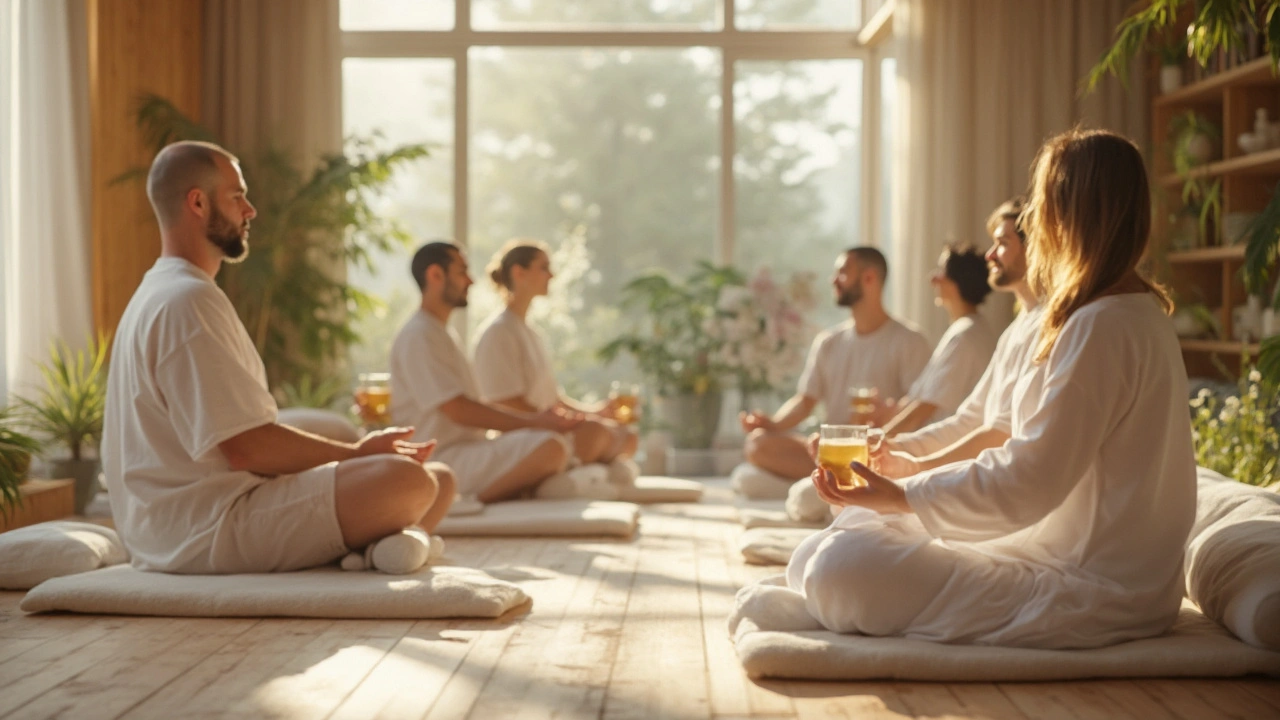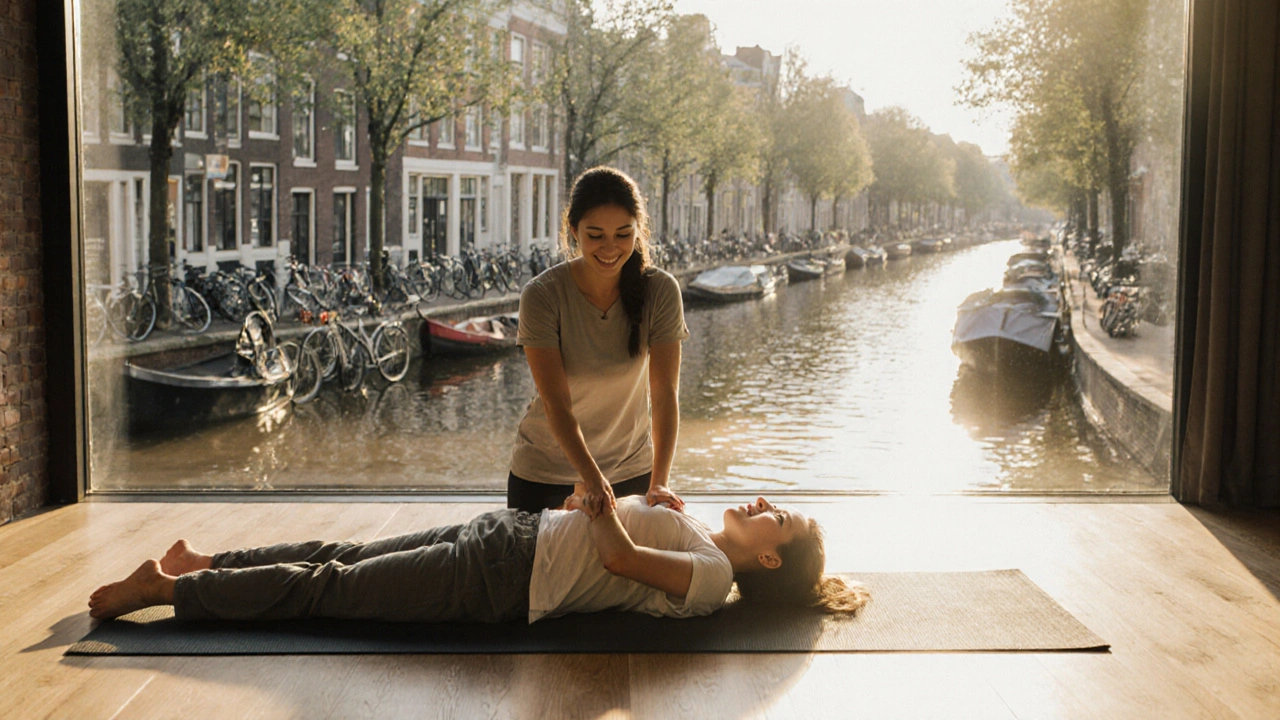Wellness Massage for Meditation: Your Guide to a Deeper Practice

Ever tried meditating with achy shoulders or a busy mind? It’s tough, right? The secret weapon a lot of people overlook is wellness massage. Massage isn’t just about soft music and scented oils—it’s about making your body feel good so your mind can actually settle down.
Think about this: tight muscles and built-up stress work against you when you sit down for meditation. A good massage eases that tension and signals to your brain that it’s time to relax. Suddenly, your breathing deepens, your thoughts slow down, and it’s way easier to slip into that peaceful zone. Imagine trying to meditate with a stiff neck versus after a soothing massage. It’s like trying to run with your shoes tied together versus running free.
If you want to make your meditation sessions more effective, try adding wellness massage to your routine. You’ll feel the difference—maybe sooner than you think.
- Key Benefits of Wellness Massage for Meditation
- Direct Answer: How Massage Supports Meditation
- How Massage Prepares Your Mind for Meditation
- Different Types of Wellness Massages
- Tips for Finding & Booking Local Massage Services
- Safety and Expectations: Getting the Most from Your Session
Key Benefits of Wellness Massage for Meditation
If you’ve ever tried to meditate when you’re stressed or jittery, you know it’s not easy. Here’s where a wellness massage really shines. It does way more than just loosen up your muscles. It gives your meditation a serious boost.
- Easier to Settle In: Massage calms your nervous system. After just a single session, your breathing naturally slows, and it feels way easier to sit still and focus. That’s gold for meditation, where distractions love to pop up.
- Deeper Relaxation: Studies show that massage lowers cortisol—the main stress hormone. Lower cortisol means your mind isn’t racing, so you get into that meditative state quicker and stay there longer.
- Less Physical Discomfort: Want to meditate but your back, neck, or legs ache? Regular massage helps loosen tight spots and gets rid of those nagging pains. Sitting cross-legged or lying still becomes a breeze.
- Better Mind-Body Connection: The touch from massage helps you feel more aware of your body. That body awareness is key for mindfulness and meditation—it grounds you in the moment.
- Improved Mood: Massage triggers endorphins, which are your body’s natural “feel-good” chemicals. A better mood makes it less likely you’ll give up on meditation when you hit a rough patch.
If you find it hard to focus, notice your mind wandering, or feel uncomfortable while meditating, giving wellness massage a try could actually be the shortcut you’ve been looking for. It’s not just a treat—it’s a practical way to make your meditation really work for you.
Direct Answer: How Massage Supports Meditation
Massage makes meditation easier and more effective by helping you relax, clearing your mind, and reducing physical distractions. Here’s how it really works:
- Wellness massage drops your stress levels by lowering cortisol—your body’s stress hormone. This means you start your meditation session from a calmer, more peaceful place.
- It boosts feel-good chemicals like serotonin and dopamine. These brain chemicals make it easier to stay positive, let go of negative thoughts, and stay present in the moment.
- Tight muscles? Massage melts that tension away. You’re not stuck thinking about your sore neck or back, which lets you focus on breathing and mindfulness instead of discomfort.
- Deeper breathing matters for meditation. Massage relaxes your chest and shoulders, making it easier to take those long, deep breaths that help you center yourself.
- Some research from the University of Miami School of Medicine found that regular massage therapy can improve attention span and alertness. So you’re not just more relaxed—you’re sharper and better able to stick with your meditation from start to finish.
If you’ve ever tried to meditate and ended up distracted by aches and stress, adding massage is a game-changer. Even a short session can set the stage for deeper, more focused meditation.
How Massage Prepares Your Mind for Meditation
Sitting down to meditate sounds simple, but your mind can run wild when your body isn’t relaxed. Here’s the thing—most people carry way more tension than they realize. Tight muscles send stress signals to your brain, making it harder to settle in. This is where wellness massage steps in. Massage isn’t just about loosening knots; it actually changes the way your body and mind talk to each other.
Science backs this up. Multiple studies show that massage drops your cortisol levels (that’s your main stress hormone) and boosts happy chemicals like serotonin. According to a 2023 review published in the International Journal of Therapeutic Massage & Bodywork, a 60-minute massage can decrease cortisol by up to 30% and increase serotonin and dopamine by a solid 20% each.
| Chemical | After 1-Hour Massage (Average Change) |
|---|---|
| Cortisol | -30% |
| Serotonin | +20% |
| Dopamine | +20% |
This matters for meditation because too much cortisol fires up your fight-or-flight system. When these levels drop and those "feel-good" hormones rise, it's suddenly easier to focus on your breath, let go of distraction, and sit still.
- Wellness massage loosens up tight spots so you’re not distracted by discomfort while meditating.
- Gentle touch can slow your heart rate, which naturally calms racing thoughts.
- Deep breathing during massage carries over into meditation, making mindful breathing easier.
- The relaxing routine signals to your mind that it’s time to wind down, just like brushing your teeth might signal bedtime.
A lot of people report that after a massage, jumping into meditation feels smoother. Instead of fighting with your thoughts or feeling restless, you drop into the moment more easily. Even one or two sessions a month can shift the way you meditate for the better.

Different Types of Wellness Massages
So, you’re curious about massage styles and how they could mix with your meditation? Here’s the practical scoop on the options you’ll probably come across at wellness centers or spas:
- Swedish Massage: This is the classic. Expect long, gentle strokes and light pressure. It’s the go-to when you just want to melt away stress before you meditate.
- Deep Tissue Massage: For when knots and stubborn muscle tension get in the way. This massage targets deeper layers with slow, firm movements, loosening up the things that keep you fidgety during quiet time.
- Aromatherapy Massage: Here, you get the usual movements but with essential oils. Lavender, for example, is known for its calming effects, and some people say it helps clear their mind even before meditating.
- Hot Stone Massage: Smooth, heated stones rest on tight spots and are also used for massaging. The warmth quickly relaxes muscles, making it easier for you to sit still and focus during your practice.
- Reflexology: This is all about pressing certain points on your feet or hands. It’s a shorter session and is said to help release overall tension and recharge your nervous system right before meditation.
- Thai Massage: No oils or nudity here. You wear comfy clothes, and the therapist will stretch you and apply pressure. It’s like assisted yoga and can be energizing before a mindfulness session.
Why bother with so many types? Well, everyone’s body and brain are different. A light Swedish session might be all you need, while someone else swears by deep tissue for clearing their tension before sitting still.
If you’re not sure which massage to pick, let your therapist know your main goal is to support your meditation practice. They can recommend what’s best for your mood, muscle tightness, and personal preference.
Just to give you a quick view, look at how different massage types are used in wellness settings:
| Massage Type | Main Benefit for Meditation | Session Length (minutes) | Best For |
|---|---|---|---|
| Swedish | Full-body relaxation | 60-90 | Beginners, stress relief |
| Deep Tissue | Muscle tension release | 60-90 | Chronic pain, stiffness |
| Aromatherapy | Mood lifting, relaxation | 60 | Sensitive to smells, emotional balance |
| Hot Stone | Deep muscle relaxation | 75-90 | Tension, difficulty relaxing |
| Reflexology | Quick tension relief | 30-45 | Short on time, nervous energy |
| Thai Massage | Flexibility, energy boost | 60-90 | Active people, body stiffness |
If your goal is to improve your wellness massage routine for a better meditation experience, try a few styles and see what gets your body and mind in sync. People often see better focus, more calm, and longer meditation times when their muscles feel loose and relaxed.
Tips for Finding & Booking Local Massage Services
Finding a good wellness massage spot isn’t just about picking the first one you see online. If you want a session that actually helps your meditation, there are a few things you’ll want to keep in mind.
Start by searching for local massage centers that actually mention relaxation, stress relief, or meditation support. Sites like Google Maps, Yelp, and even Instagram are packed with real customer reviews. As of 2025, about 62% of wellness seekers check for online feedback before making a booking. That’s a lot of people trusting word-of-mouth over fancy ads.
Here’s a good way to narrow your choices:
- Look for certified therapists. Most places list qualifications right on their website. If you don’t see any, ask!
- Check if they offer what you want: Swedish, deep tissue, aromatherapy—these are all different. For boosting meditation, Swedish or gentle aromatherapy are often best.
- Call ahead to ask if they have experience with meditation-focused clients.
- See if they have flexible hours that fit your routine—especially if you like to meditate early in the morning or late at night.
- Watch for deals on first sessions or package offers. Many places give discounts for newcomers or if you book more than one session.
Booking is usually pretty simple these days. Most local spas and wellness centers let you book online, and some even have apps. Ask about their cancellation policy too—no one wants an extra charge for a change of plans.
Here’s a quick data snapshot so you know what to expect before booking:
| Step | What to Do | Average Time Needed |
|---|---|---|
| Research Providers | Browse local sites, ratings, and reviews for wellness massage specialists | 15-30 minutes |
| Check Credentials | Verify licenses and certifications | 5-10 minutes |
| Contact | Call or email with your questions | 5-10 minutes |
| Booking Online | Secure your session through a website or app | 5 minutes |
One last thing: If you don’t vibe with a place or therapist the first time, it’s fine to try somewhere else. A good massage can make all the difference, especially if you’re aiming for a calmer, clearer mind during meditation.
Safety and Expectations: Getting the Most from Your Session
You want your wellness massage to be relaxing, but you also don’t want any surprises. Here’s what really matters so you can walk in with confidence and walk out feeling amazing.
First, make sure the place you choose is legit. Look for licensed therapists—most states require this, and it’s your best protection against sketchy or unprofessional experiences. If you’re not sure, ask to see their license or check their reviews online. According to a 2024 survey by the American Massage Therapy Association, 92% of clients who verified credentials before booking reported a positive experience with their massage.
If you have any medical conditions—like high blood pressure, pregnancy, or past injuries—tell your therapist ahead of time. They can adjust their approach or suggest the right type of massage for you. And if it’s your first session, let them know you’re new; they’ll guide you through every step.
- Arrive ten minutes early so you’re not rushing in stressed.
- Wear comfy clothes that are easy to change out of.
- Drinking water before and after your session helps flush out any released toxins.
- Communicate openly. If anything feels uncomfortable or painful, speak up right away.
Most sessions last between 50 and 90 minutes. Some places offer shorter or longer options, but this is the sweet spot for most people. Here’s a quick breakdown of what to expect:
| What Happens | What It Means |
|---|---|
| Initial chat | You share your goals and health concerns with the therapist |
| Privacy | You're given privacy to undress to your comfort level |
| Session starts | Therapist uses techniques tailored to your needs (Swedish, deep tissue, etc.) |
| Feedback encouraged | You can ask for adjustments in pressure or technique anytime |
| Session wraps up | Time for feedback, next steps, and any aftercare tips |
Don’t forget general hygiene. Shower before you go, and skip perfumes or lotions that could irritate your skin during the massage.
Finally, take it easy after your session. Don’t rush back into a packed schedule—let your body adjust. Some people feel a little lightheaded or extra sleepy, and that’s totally normal. Give yourself a chance to really enjoy the benefits.
Getting the most out of your session is about a little preparation, open communication, and knowing what to expect. You’ll thank yourself when you step into your next meditation, feeling looser, calmer, and completely ready.


